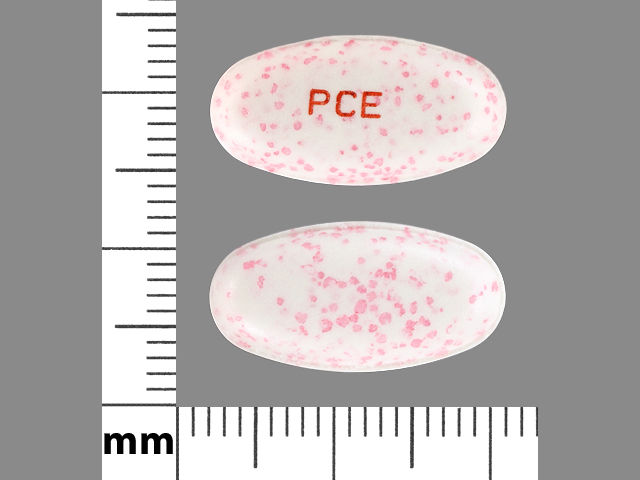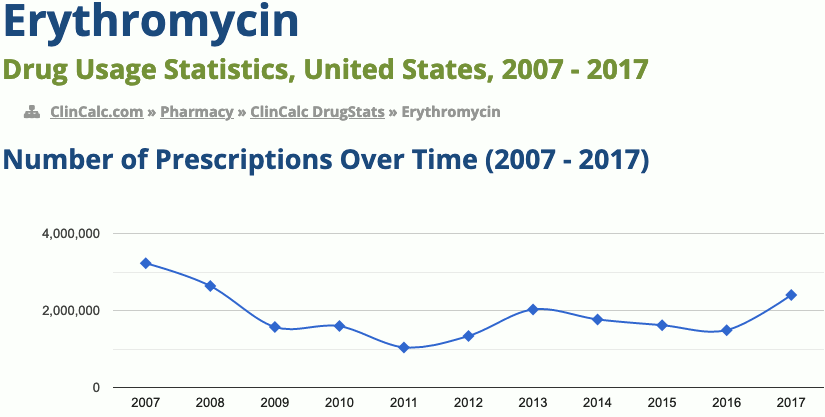[ Home ] [ Controlled Substances ] [ Prescription ]
PCE
|
PCE stands for Polymer Coated Erythromycin.
It is classified as a macrolide antibiotic. PCE is used to treat various infections caused by susceptible bacteria. PCE will not successfully treat viral infections, such as flu or colds.

https://www.sharecare.com/health/macrolides/what-is-erythromycin-pce
What is Erythromycin?
Erythromycin is a medicine called an antibiotic. Antibiotics are used to treat or prevent certain types of infections caused by germs called bacteria. It can also be used for acne or certain types of digestive disorders. You may hear erythromycin called by its brand names: ERYC, EES, or PCE.
Erythromycin comes in:
- Tablet
- Capsule
- Liquid
- Eye ointment
- Injection form
- Topical skin product

PCE Erythromycin 333 MG
PCE tablets (erythromycin particles in tablets):
Are an antibacterial product containing specially coated erythromycin base particles for oral administration. The coating protects the antibiotic from the inactivating effects of gastric acidity and permits efficient absorption of the antibiotic in the small intestine. PCE tablets are available in two strengths containing either 333 mg or 500 mg of erythromycin base. PCE tablets 500 mg tablets contain no synthetic dyes or artificial colors.


https://www.accessdata.fda.gov/drugsatfda_docs/label/2012/050611s035lbl.pdf
About Erythromycin:
- It's widely used to treat chest infections, such as pneumonia, skin problems, such as acne and rosacea, dental abscesses, and sexually transmitted infections.
- Erythromycin is used in children, often to treat ear infections or chest infections.
- Erythromycin is an antibiotic.
- The medicine is available on prescription as tablets, capsules, or a liquid that you drink.
- It's also available as a skin solution to treat skin infections like acne. It can be given by injection, but this is usually only done in hospital.
Key Facts:
- Take erythromycin 2 or 4 times a day as prescribed by your doctor.
- For most infections, you should feel better within a few days.
- For skin conditions like acne and rosacea, it may take a couple of months before you see an improvement.
- The most common side effects of erythromycin are feeling or being sick (nausea or vomiting), stomach cramps and diarrhoea.
- Drinking alcohol with erythromycin may slightly reduce or delay the medicine's benefits.
- Erythromcyin is also called by the brand names:
- Erythrocin
- Erythrolar
- Erymax
- Tiloryth
- Rommix
- Erythroped A
- Erythroped
- Erythromycin can be taken by adults, including pregnant and breastfeeding women.
- Erythromycin can be taken by children.
How much will I take?
- The usual dose of erythromycin is 250mg to 1,000mg taken 4 times a day. Sometimes it's taken twice a day. The dose may be lower for children.
If you or your child are taking erythromycin as a liquid, it'll usually be made up for you by your pharmacist. The medicine will come with a syringe or spoon to help you take the right amount. If you don't have a syringe or spoon, ask your pharmacist for one. Do not use a kitchen teaspoon as it will not give the right amount.
When will I feel better?
- For most infections, you should feel better within a few days.
- For skin problems such as acne and rosacea, expect to take the medicine for at least 2 months before you see much improvement.
- It's very important that you keep taking erythromycin until your course is finished. Do this even if you feel better. It will help to stop the infection coming back.
Erythromycin cyclocarbonate (Davercin) is a first generation semi-synthetic erythromycin. It is active against Gram-positive and some Gram-negative microorganisms. Davercin shows comparable or better in vitro potency, low host toxicity and improved pharmacokinetics compared with erythromycin. It is approved for the treatment of acne, atypical pneumonia (caused by Mycoplasma pneumoniae, Chlamydia pneumoniae, Legionella pneumophila), whooping cough (treatment and prevention), urethritis (caused by Ureaplasma urealyticum and Chlamydia trachomatis), gastrointestinal infection caused by Campylobacter spp., short-term infections of the skin and soft tissues (e.g. acne, staphylococcal dermatitis). In streptococcal infections, diphtheria, gonorrhea, early syphilis in patients who are allergic to penicillin, and in the prevention of bacterial endocarditis before the planned dental procedures. Adverse effects are: nausea, vomiting, abdominal pain, diarrhea, skin allergic reactions.
 Erythromycin:
Erythromycin:
https://drugs.ncats.io/drug/63937KV33D

215th most prescribed medicine in the United States for 2017

https://clincalc.com/DrugStats/Drugs/Erythromycin
| Side Effects: |
| Get emergency medical help if you have signs of an allergic reaction (hives, difficult breathing, swelling in your face or throat) or a severe skin reaction (fever, sore throat, burning eyes, skin pain, red or purple skin rash with blistering and peeling). |
|---|
| RxList |

Erythromycin (PCE): https://www.rxlist.com/pce-drug/patient-images-side-effects.htm |
Call your doctor at once if you have:
|
| Serious side effects may be more likely in older adults, including hearing loss, or a life-threatening fast heart rate. |
| Call your doctor if a baby using this medicine is vomiting or irritable with feeding. |
Common side effects may include:
|
| This is not a complete list of side effects and others may occur. Call your doctor for medical advice about side effects. You may report side effects to FDA at 1-800-FDA-1088. |
Interactions:
Drug Interactions (581) Alcohol/Food Interactions (2) Disease Interactions (5)
What other drugs will affect PCE?
A total of 581 drugs are known to interact with PCE.
- 166 major drug interactions
- 360 moderate drug interactions
- 55 minor drug interactions
 PCE (Oral) Interactions:
PCE (Oral) Interactions:
https://www.drugs.com/cons/pce.html
Adult Dosage:
Give preferably 2hrs before meals. Usual dose: 333mg every 8hrs or 500mg every 12hrs; max 4g/day (1g/day for twice daily dosing). Legionnaires: 1 - 4g daily in divided doses. Prophylaxis: 250mg twice daily. See full labeling.
Children Dosage:
Give preferably 2hrs before meals. Usual dose: 30 - 50mg/kg/day in divided doses; may double dose in severe infections. Max 4g/day. See full labeling.

https://www.empr.com/drug/erythromycin-tablets/
| Maximum Dosage: | |
|---|---|
| Prescribers Digital Reference | |

PCE Tablets - Drug Summary: https://www.pdr.net/drug-summary/PCE-Tablets-erythromycin-3327 | |
| Adults: | 4 g erythromycin base/day PO; 4 g/day IV. |
| Geriatric: | 4 g erythromycin base/day PO; 4 g/day IV. |
| Adolescents: | 50 mg/kg/day (Max: 2 g/day) PO is the common maximum dose used in clinical practice; however, up to 100 mg/kg/day PO (Max: 4 g/day) is FDA-approved for the treatment of severe infections. 20 mg/kg/day (Max: 4 g/day) is the FDA-approved IV maximum dose; however, doses up to 40 mg/kg/day (Max: 4 g/day) IV have been used off-label. |
| Children: | 50 mg/kg/day (Max: 2 g/day) PO is the common maximum dose used in clinical practice; however, up to 100 mg/kg/day PO (Max: 4 g/day) is FDA-approved for the treatment of severe infections. 20 mg/kg/day (Max: 4 g/day) is the FDA-approved IV maximum dose; however, doses up to 40 mg/kg/day (Max: 4 g/day) IV have been used off-label. |
| Infants: | 50 mg/kg/day PO is the common maximum dose used in clinical practice; however, up to 100 mg/kg/day PO is FDA-approved for the treatment of severe infections. 20 mg/kg/day is the FDA-approved maximum IV dose; however, doses up to 40 mg/kg/day IV have been used off-label. |
| Neonates: | 50 mg/kg/day PO; safety and efficacy of IV use have not been established, however, doses up to 40 mg/kg/day IV have been used off-label. |
Acne:
Erythromycin is a topical antibiotic that is used to treat inflammatory acne. It comes in many different forms, from lotions, gels, and ointments, to toner-like solutions and pledgets (small pads soaked in the medicated solution, similar to a Stridex pad). You can only get topical erythromycin with a prescription. Oral erythromycin is also used to treat acne.
How It Works:
One factor of acne development is a proliferation of acne-causing bacteria within the pore. The Propionibacterium acnes is the chief culprit here. Antibiotics like erythromycin reduce the amount of acne-causing bacteria and infection. Topical erythromycin can also help decrease redness and inflammation.
Topical Erythromycin Isn't the First Treatment Choice;
It isn't incredibly effective against acne, and there are plenty of other options that simply work better. Topical erythromycin only targets one acne-causing factor: bacteria. There are other factors that are responsible for acne breakouts, like the abnormal shedding of skin cells and the development of pore blockages, that topical erythromycin just doesn't address. More importantly, a big issue with topical antibiotics and erythromycin, in particular, is antibiotic resistance. The bacterium that causes acne has become used to the medication, so it no longer works against it.1 In some cases, though, erythromycin is the best treatment choice.
don't use erythromycin as the sole acne treatment. It works much better if it's paired with a second acne medication, like benzoyl peroxide or a topical retinoid.

https://www.verywellhealth.com/topical-erythromycin-15882
Brand names:
- EryPed
- Erythrocin
- Ery-Tab
- Eryc
- E-Mycin
- Erythrocin Lactobionate
- Erythrocin Stearate Filmtab
- Ilosone
- Robimycin
- PCE Dispertab
- E.E.S. Granules
- E.E.S.-200
- E.E.S.-400
- E.E.S.-400 Filmtab
- Erythrocot
- Wyamycin S
- MY-E
 Erythromycin (Systemic) Information:
Erythromycin (Systemic) Information:
https://www.medicine.com/drug/erythromycin-systemic/hcp/a>
 Erowid Experience Vault:
Erowid Experience Vault:
https://erowid.org/experiences/subs/exp_PCE.shtml

 Erybid, EES - 200/400, PCE Prescribing Information (PDF 13 pages):
Erybid, EES - 200/400, PCE Prescribing Information (PDF 13 pages):
https://pdf.hres.ca/dpd_pm/00008382.PDF
 Erythromycin Drug Labels (101 of them):
Erythromycin Drug Labels (101 of them):
https://dailymed.nlm.nih.gov/dailymed/search.cfm?query=Erythromycin
An antibiotic used for the treatment of a number of bacterial infections. This includes respiratory tract infections, skin infections, chlamydia infections, pelvic inflammatory disease, and syphilis. Common side effects include abdominal cramps, vomiting, and diarrhea. More serious side effects may include Clostridium difficile colitis, liver problems, prolonged QT, and allergic reactions. It is in the macrolide family of antibiotics and works by decreasing bacterial protein production.Erythromycin was first isolated in 1952. It is on the World Health Organization's List of Essential Medicines, the safest and most effective medicines needed in a health system. The World Health Organization classifies it as critically important for human medicine. In 2017, it was the 215th most commonly prescribed medication in the United States, with more than two million prescriptions.
Wednesday December 11, 2024 - jdsupra.comPCE in Drinking Water Linked to an Increased Risk of Mental Illness - The solvent tetrachloroethylene (PCE) widely used in industry and to dry clean clothes is a neurotoxin known to cause mood changes, anxiety, and depression in people who work with it. To date the long ...
Tuesday January 17, 2012 - technologynetworks.com
Prescription | Link to this page
[ Home ] [ Controlled Substances ] [ Sources ]







